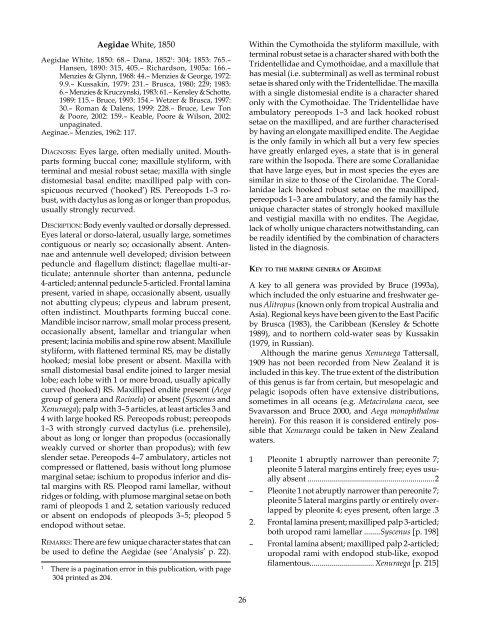The Marine Fauna of New Zealand: Isopoda, Aegidae (Crustacea)
The Marine Fauna of New Zealand: Isopoda, Aegidae (Crustacea)
The Marine Fauna of New Zealand: Isopoda, Aegidae (Crustacea)
Create successful ePaper yourself
Turn your PDF publications into a flip-book with our unique Google optimized e-Paper software.
<strong>Aegidae</strong> White, 850<br />
<strong>Aegidae</strong> White, 850: 68.– Dana, 852 : 304; 853: 765.–<br />
Hansen, 890: 3 5, 405.– Richardson, 905a: 66.–<br />
Menzies & Glynn, 968: 44.– Menzies & George, 972:<br />
9.9.– Kussakin, 979: 23 .– Brusca, 980: 229; 983:<br />
6.– Menzies & Kruczynski, 983: 6 .– Kensley & Schotte,<br />
989: 5.– Bruce, 993: 54.– Wetzer & Brusca, 997:<br />
30.– Roman & Dalens, 999: 228.– Bruce, Lew Ton<br />
& Poore, 2002: 59.– Keable, Poore & Wilson, 2002:<br />
unpaginated.<br />
Aeginae.– Menzies, 962: 7.<br />
diagnosis: Eyes large, <strong>of</strong>ten medially united. Mouthparts<br />
forming buccal cone; maxillule styliform, with<br />
terminal and mesial robust setae; maxilla with single<br />
distomesial basal endite; maxilliped palp with conspicuous<br />
recurved (‘hooked’) RS. Pereopods –3 robust,<br />
with dactylus as long as or longer than propodus,<br />
usually strongly recurved.<br />
desCription: Body evenly vaulted or dorsally depressed.<br />
Eyes lateral or dorso-lateral, usually large, sometimes<br />
contiguous or nearly so; occasionally absent. Antennae<br />
and antennule well developed; division between<br />
peduncle and flagellum distinct; flagellae multi-articulate;<br />
antennule shorter than antenna, peduncle<br />
4-articled; antennal peduncle 5-articled. Frontal lamina<br />
present, varied in shape, occasionally absent, usually<br />
not abutting clypeus; clypeus and labrum present,<br />
<strong>of</strong>ten indistinct. Mouthparts forming buccal cone.<br />
Mandible incisor narrow, small molar process present,<br />
occasionally absent, lamellar and triangular when<br />
present; lacinia mobilis and spine row absent. Maxillule<br />
styliform, with flattened terminal RS, may be distally<br />
hooked; mesial lobe present or absent. Maxilla with<br />
small distomesial basal endite joined to larger mesial<br />
lobe; each lobe with or more broad, usually apically<br />
curved (hooked) RS. Maxilliped endite present (Aega<br />
group <strong>of</strong> genera and Rocinela) or absent (Syscenus and<br />
Xenuraega); palp with 3–5 articles, at least articles 3 and<br />
4 with large hooked RS. Pereopods robust; pereopods<br />
–3 with strongly curved dactylus (i.e. prehensile),<br />
about as long or longer than propodus (occasionally<br />
weakly curved or shorter than propodus); with few<br />
slender setae. Pereopods 4–7 ambulatory, articles not<br />
compressed or flattened, basis without long plumose<br />
marginal setae; ischium to propodus inferior and distal<br />
margins with RS. Pleopod rami lamellar, without<br />
ridges or folding, with plumose marginal setae on both<br />
rami <strong>of</strong> pleopods and 2, setation variously reduced<br />
or absent on endopods <strong>of</strong> pleopods 3–5; pleopod 5<br />
endopod without setae.<br />
remarks: <strong>The</strong>re are few unique character states that can<br />
be used to define the <strong>Aegidae</strong> (see ‘Analysis’ p. 22).<br />
<strong>The</strong>re is a pagination error in this publication, with page<br />
304 printed as 204.<br />
26<br />
Within the Cymothoida the styliform maxillule, with<br />
terminal robust setae is a character shared with both the<br />
Tridentellidae and Cymothoidae, and a maxillule that<br />
has mesial (i.e. subterminal) as well as terminal robust<br />
setae is shared only with the Tridentellidae. <strong>The</strong> maxilla<br />
with a single distomesial endite is a character shared<br />
only with the Cymothoidae. <strong>The</strong> Tridentellidae have<br />
ambulatory pereopods –3 and lack hooked robust<br />
setae on the maxilliped, and are further characterised<br />
by having an elongate maxilliped endite. <strong>The</strong> <strong>Aegidae</strong><br />
is the only family in which all but a very few species<br />
have greatly enlarged eyes, a state that is in general<br />
rare within the <strong>Isopoda</strong>. <strong>The</strong>re are some Corallanidae<br />
that have large eyes, but in most species the eyes are<br />
similar in size to those <strong>of</strong> the Cirolanidae. <strong>The</strong> Corallanidae<br />
lack hooked robust setae on the maxilliped,<br />
pereopods –3 are ambulatory, and the family has the<br />
unique character states <strong>of</strong> strongly hooked maxillule<br />
and vestigial maxilla with no endites. <strong>The</strong> <strong>Aegidae</strong>,<br />
lack <strong>of</strong> wholly unique characters notwithstanding, can<br />
be readily identified by the combination <strong>of</strong> characters<br />
listed in the diagnosis.<br />
Key to the marine genera <strong>of</strong> aegidae<br />
A key to all genera was provided by Bruce ( 993a),<br />
which included the only estuarine and freshwater genus<br />
Alitropus (known only from tropical Australia and<br />
Asia). Regional keys have been given to the East Pacific<br />
by Brusca ( 983), the Caribbean (Kensley & Schotte<br />
989), and to northern cold-water seas by Kussakin<br />
( 979, in Russian).<br />
Although the marine genus Xenuraega Tattersall,<br />
909 has not been recorded from <strong>New</strong> <strong>Zealand</strong> it is<br />
included in this key. <strong>The</strong> true extent <strong>of</strong> the distribution<br />
<strong>of</strong> this genus is far from certain, but mesopelagic and<br />
pelagic isopods <strong>of</strong>ten have extensive distributions,<br />
sometimes in all oceans (e.g. Metacirolana caeca, see<br />
Svavarsson and Bruce 2000, and Aega monophthalma<br />
herein). For this reason it is considered entirely possible<br />
that Xenuraega could be taken in <strong>New</strong> <strong>Zealand</strong><br />
waters.<br />
Pleonite abruptly narrower than pereonite 7;<br />
pleonite 5 lateral margins entirely free; eyes usually<br />
absent ...............................................................2<br />
– Pleonite not abruptly narrower than pereonite 7;<br />
pleonite 5 lateral margins partly or entirely overlapped<br />
by pleonite 4; eyes present, <strong>of</strong>ten large .3<br />
2. Frontal lamina present; maxilliped palp 3-articled;<br />
both uropod rami lamellar ........Syscenus [p. 98]<br />
– Frontal lamina absent; maxilliped palp 2-articled;<br />
uropodal rami with endopod stub-like, exopod<br />
filamentous................................Xenuraega [p. 2 5]

















